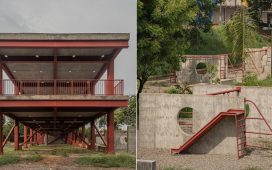Startup Village Jülich redefines the concept of the workspace
In Germany, the Startup Village Jülich redefines the concept of the workspace by transforming it into a lively ecosystem of modular architecture, greenery, and community engagement. Designed by Julius Taminiau Architects, the project is a vibrant hub for startups and sustainable innovation, organized on a flexible hexagonal grid, colorful modular units, and integrated green spaces. Inspired by Jülich’s Renaissance citadel, the design reimagines these historical forms as a welcoming, adaptive environment for a dynamic ecosystem for creativity.
For the Dutch design team, sustainability is a defining feature. Each module is constructed primarily using locally sourced wood, assembled with wooden nails rather than glue to facilitate future disassembly and recycling. High insulation and large windows ensure energy efficiency and natural cross-ventilation, minimizing the need for mechanical cooling. The integration of greenery — including rainwater-buffering green roofs and plantings — fosters biodiversity and enhances the ecological footprint of the site.

all images courtesy of Julius Taminiau Architects
Julius Taminiau Architects integrates green features
Startup Village Jülich is a vibrant addition to Brainergy Park, a 7-hectare ‘energy transition’ business park developed as part of the local shift from a coal-dependent economy. This dynamically designed village stands in contrast to the park’s more formal, orthogonal, white-toned architecture. The team at Julius Taminiau Architects has organized the project on a hexagonal grid which provides a flexible foundation for growth and adaptation. Each cell in the grid contains modular office units designed to be affordable workspaces for startups, which much like the garage beginnings of companies like Apple and Microsoft, serve as launchpads for transformative ideas. Grouped together, these ‘garages’ foster a vibrant village setting where startups from various sectors can connect, collaborate, and inspire unexpected innovations.
The hexagonal design also references Jülich’s Renaissance citadel, historically a bastion of protection. In this reinterpretation, the Startup Village shifts the focus from defense to openness, with its central hub — a spacious main building — acting as the heart of the community. With expansive sliding windows and generous outdoor seating, the building invites interaction, reinforcing the Village’s openness and inclusivity.

Startup Village Jülich redefines the concept of the workspace
in dialogue with local village architecture
Visually, the modular units draw inspiration from the vibrant hues of local village houses, lending the site a sense of warmth and familiarity. Julius Taminiau Architects weaves greenery throughout the village, with deciduous trees providing natural summer shading, while the main building’s green roof enhances biodiversity and reduces heat absorption. This interplay of architecture and nature creates a ‘beehive’ atmosphere where ideas and connections organically flourish.
The recently completed Phase 1 of the project has already demonstrated its appeal, with all modular units fully rented out. This success sets the stage for Phase 2, expected by 2025/26.

a lively ecosystem of modular architecture, greenery, and community engagement

designed by Julius Taminiau Architects

the design reimagines Jülich’s Renaissance citadel as an adaptive environment for an ecosystem for creativity

each module is constructed primarily using locally sourced wood, assembled with wooden nails rather than glue

the integration of greenery fosters biodiversity and enhances the ecological footprint of the site

deciduous trees providing natural summer shading

the project is organized on a hexagonal grid which provides a flexible foundation for growth and adaptation

the modular units draw inspiration from the vibrant hues of local village houses

each cell in the grid contains modular office units designed to be affordable workspaces for startups

Startup Village Jülich integrates rainwater-buffering green roofs and plantings










